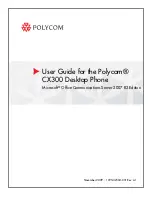
17-42
Cisco ONS 15454 Procedure Guide, R5.0
March 2005
Chapter 17 DLPs A1 to A99
DLP-A36 Install the TCC2/TCC2P Cards
•
Reversion time—If Revertive is checked, choose a reversion time from the drop-down list. The
range is 0.5 to 12.0 minutes. The default is 5.0 minutes. Reversion time is the amount of time that
will elapse before the primary channel is automatically renamed as secondary and the secondary
channel is renamed as primary.
•
Verification guard time—Choose the verification guard time from the drop-down list. The range is
500ms to 1s. A verification guard timer is used to ensure the acceptance of a Force switch command
from the far-end node. When the Force command is received, if no Lockout is present or if the secondary
section is not in a failed state, then the outgoing K1 byte is changed to indicate Force and the verification
guard timer is started. If a Force user command is not acknowledged by the far-end within the verification
guard timer duration, then the Force command is cleared.
•
Recovery guard time—Choose the recovery guard time from the drop-down list. The range is 0s to
10s. The default is 1s. A recovery guard timer is used for preventing rapid switches due to SD/SF
failures. After the SD/SF failure is cleared on the line, a recovery guard timer is started. Recovery guard
time is the amount of time elapsed before the system declares that a condition is cleared after the
detection of an SD/SF failure.
•
Detection guard time—Choose the detection guard time from the drop-down list. The range is 0s to
5s. The default is 1 second. The detection guard timer is started after detecting an
SD/SF/LOS/LOF/AIS-L failure. Detection guard time is the amount of time elapsed before a traffic
switch is initiated to a standby card after the detection of an SD/SF/LOS/LOF/AIS-L failure on the active
card.
Step 4
Click
Apply
. Confirm that the changes appear; if not, repeat the task.
Step 5
Return to your originating procedure (NTP).
DLP-A36 Install the TCC2/TCC2P Cards
Note
When installing cards, allow each card to boot completely before installing the next card.
Step 1
Open the latches/ejectors of the TCC2/TCC2P card that you will install.
Step 2
Use the latches/ejectors to firmly slide the card along the guide rails until the card plugs into the
receptacle at the back of the slot (Slot 7 or 11).
Step 3
Verify that the card is inserted correctly and close the latches/ejectors on the card.
Purpose
This task installs redundant TCC2/TCC2P cards. The first card you install
in the ONS 15454 must be a TCC2/TCC2P card, and it must initialize
before you install any cross-connect or traffic cards.
Tools/Equipment
Two TCC2/TCC2P cards
Prerequisite Procedures
None
Required/As Needed
Required
Onsite/Remote
Onsite
Security Level
None
Summary of Contents for ONS 15454 Series
Page 28: ...Tables xxviii Cisco ONS 15454 Procedure Guide R5 0 December 2004 ...
Page 44: ...Tasks xliv Cisco ONS 15454 Procedure Guide R5 0 December 2004 ...
Page 53: ...liii Cisco ONS 15454 Procedure Guide R5 0 December 2004 About this Guide Document Conventions ...
Page 55: ...lv Cisco ONS 15454 Procedure Guide R5 0 December 2004 About this Guide Document Conventions ...
Page 850: ...Index IN 22 Cisco ONS 15454 Procedure Guide R5 0 December 2004 description 4 11 remove 18 23 ...















































